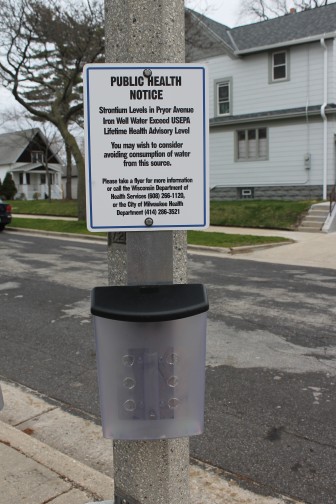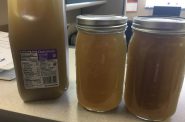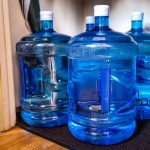Wisconsin A Leader in Strontium Pollution
73 of 100 worst readings in strontium-laced drinking water were in Waukesha, Brookfield, other towns.
Few concerns over strontium
Irving, the DHS toxicologist, shared Luczaj’s opinion that strontium “is not a concern for most people.”
“The groups of people that we might be a little more concerned about are life stages where kids’ … bones are developing,” Irving said. “And that’s just based off the animal studies that have shown that strontium maybe can affect bone development, but at a very high amount.”
Whatever the danger might be, aside from a select few residents, there does not seem to be much concern about strontium from members of the public.
Since Luczaj’s study was published and covered by local media, Brown County Public Health Sanitarian Marty Adams said he has only received a call or two.

Milwaukee posted this warning about high strontium levels in spring 2015 on the popular public well where residents fill up drinking water jugs in the city’s Bay View neighborhood. The U.S. Environmental Protection Agency is considering regulation of this naturally occurring metal, which is found in the highest concentrations nationwide in southeast Wisconsin. Consumption of strontium can lead to bone and tooth problems in children. Photo by Katherine Keller of the Bay View Compass.
“I think a lot of people just don’t understand what it is and therefore not a lot of questions have developed about it,” Adams said.
Tests of Adams’ own well water have uncovered levels of strontium between 16 and 17 mg/L, far above the EPA’s long-term health advisory level of 4 mg/L. Due to the high levels of fluoride present when Adams’ well was drilled 20 years ago, he already had a reverse osmosis system and water softener installed.
The concern is for “those that are not using softeners or reverse osmosis or distilled water or some other type of treatment that would take it out,” Adams said.
Adams emphasized that for private wells, it is up to individual homeowners to have their water tested. One resource is the State Laboratory of Hygiene. A test for heavy metals, including strontium, lead, arsenic, manganese and other elements, costs $60.
People drinking municipal water may also want to do testing, as the EPA is not likely to begin regulating strontium anytime soon.
While Schnur has tried to get his neighbors to test their water, he said the interest just has not been there.
“I just wanted people to be notified of it — that there were high levels of strontium — and it doesn’t seem like anyone really cares,” Schnur said. “Each to their own. I’m just going to make sure my family’s safe.”
Jane Roberts is the associate editor of UnDark Magazine, an online science publication headquartered in Cambridge, Massachusetts. She is a graduate of the University of Wisconsin-Madison School of Journalism and Mass Communication. Reporters Silke Schmidt and Dee J. Hall contributed to this report. This story was produced as part of The Confluence, a collaborative project involving the Wisconsin Center for Investigative Journalism and UW-Madison School of Journalism and Mass Communication reporting classes. The nonprofit Center (www.WisconsinWatch.org) collaborates with Wisconsin Public Radio, Wisconsin Public Television, other news media and the UW-Madison School of Journalism and Mass Communication. All works created, published, posted or disseminated by the Center do not necessarily reflect the views or opinions of UW-Madison or any of its affiliates.
Tainted Water
-
Fecal Microbes In 60% of Sampled Wells
 Jun 12th, 2017 by Coburn Dukehart
Jun 12th, 2017 by Coburn Dukehart
-
State’s Failures On Lead Pipes
 Jan 15th, 2017 by Cara Lombardo and Dee J. Hall
Jan 15th, 2017 by Cara Lombardo and Dee J. Hall
-
Lax Rules Expose Kids To Lead-Tainted Water
 Dec 19th, 2016 by Cara Lombardo and Dee J. Hall
Dec 19th, 2016 by Cara Lombardo and Dee J. Hall



















